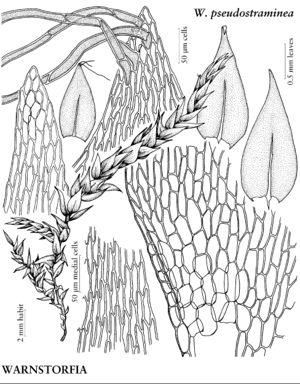Warnstorfia
Hedwigia 46: 310. 1907.
| Taxon | Illustrator ⠉ | |
|---|---|---|
 | Warnstorfia fluitans | Patricia M. Eckel |
 | Warnstorfia pseudostraminea | Patricia M. Eckel |
Plants medium-sized, green, yellow-green, brownish, redbrown, or very rarely with clear red pigment. Stems sparsely to densely radially branched; hyalodermis absent, central strand present; outer pseudoparaphyllia narrow, triangular to lanceolate, occasional one broadly triangular; rhizoids or rhizoid initials at various points on leaves, or on scattered points or in rows on stem; axillary hairs well developed, many, distal cells 1–4, hyaline. Stem-leaves triangular to ovate, gradually narrowed to apex, straight or falcate, concave, not plicate; base not decurrent or short-decurrent; margins entire or denticulate; apex acuminate, obtuse, or blunt; costa single, 1/2–4/5 leaf length; alar cells differentiated, quadrate or short to long-rectangular, inflated, hyaline, walls thin, region somewhat indistinctly delimited, narrowly transversely triangular and from margins possibly to costa, or almost quadrate with supra-alar cells often in ovate group along basal margin; medial laminal cell-walls incrassate or thin, porose or not. Sexual condition autoicous; inner perichaetial leaves not plicate; vaginula naked. Capsule with annulus not separating; exostome external surface reticulate proximally, margins dentate distally. Spores 12–31 µm.
Distribution
Nearly worldwide
Discussion
Species 2 (2 in the flora).
Warnstorfia consists of autoicous species with leaves gradually curved to straight and gradually narrowed to the apex. Clear red pigments occur very rarely in very exposed situations. The alar regions are transversely triangular or isodiametric, and consist of inflated, and (at least when young) usually hyaline cells. Warnstorfia typically occurs in mineral-poor fens, W. fluitans sometimes also in bogs. Although the species are mostly found in nutrient-poor habitats, W. fluitans can stand considerable nutrient-enrichment as evidenced by polluted localities in Europe. Warnstorfia plants with falcate leaves and lacking sporophytes or perichaetia and perigonia can be confused with similar species of Sarmentypnum. The latter, however, frequently develop red pigments, have more sharply delimited transversely triangular alar regions, and are dioicous. In addition, Sarmentypnum is found mostly in intermediately mineral-rich rather than mineral-poor habitats.
Selected References
None.
Lower Taxa
Key
| 1 | Alar regions narrowly transversely triangular; supra-alar cells small, not forming region with alar cells; stem leaf apices usually not incurved. | Warnstorfia fluitans |
| 1 | Alar regions isodiametric or sometimes transversely triangular; supra-alar cells large, forming oval or rectangular region with alar cells along basal margin; stem leaf apices incurved. | Warnstorfia pseudostraminea |